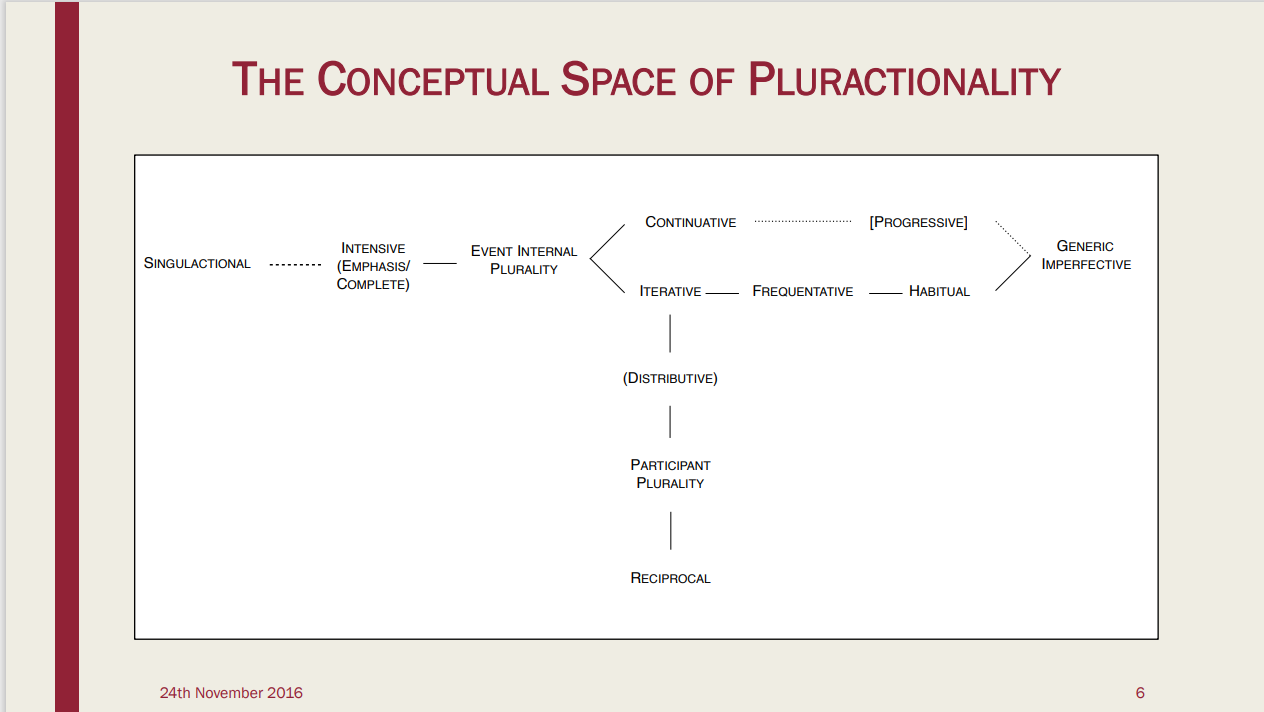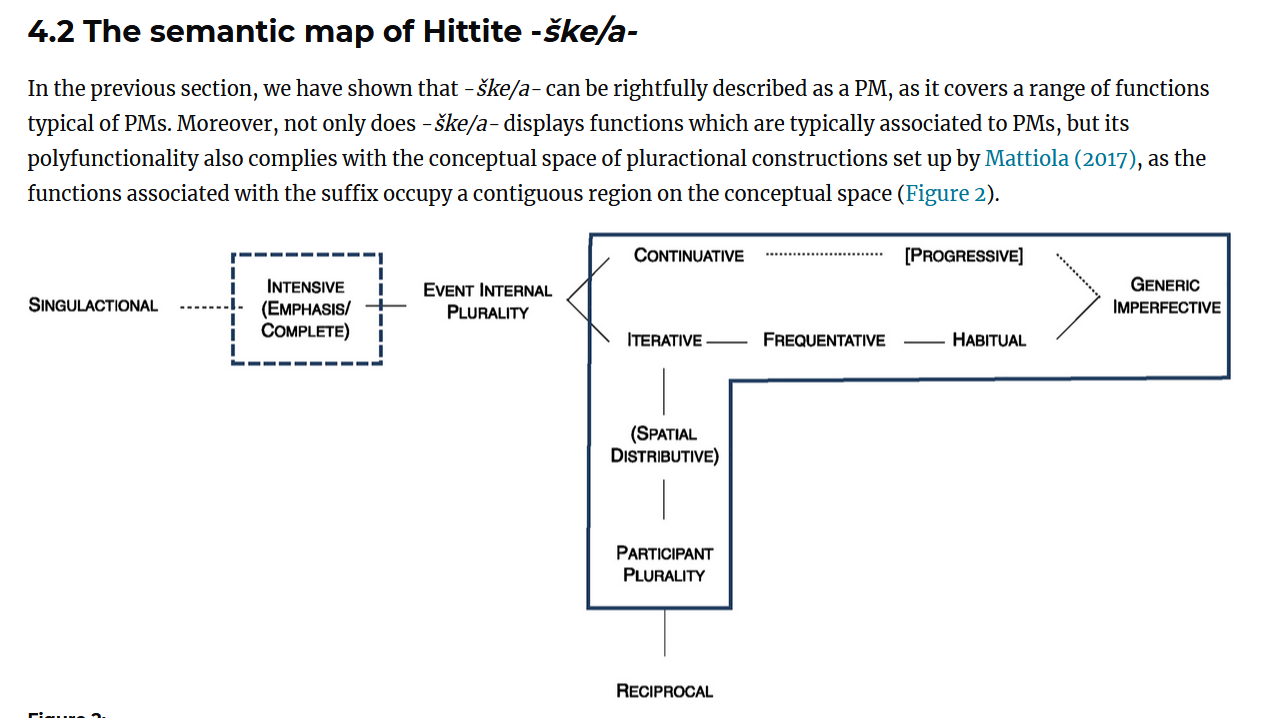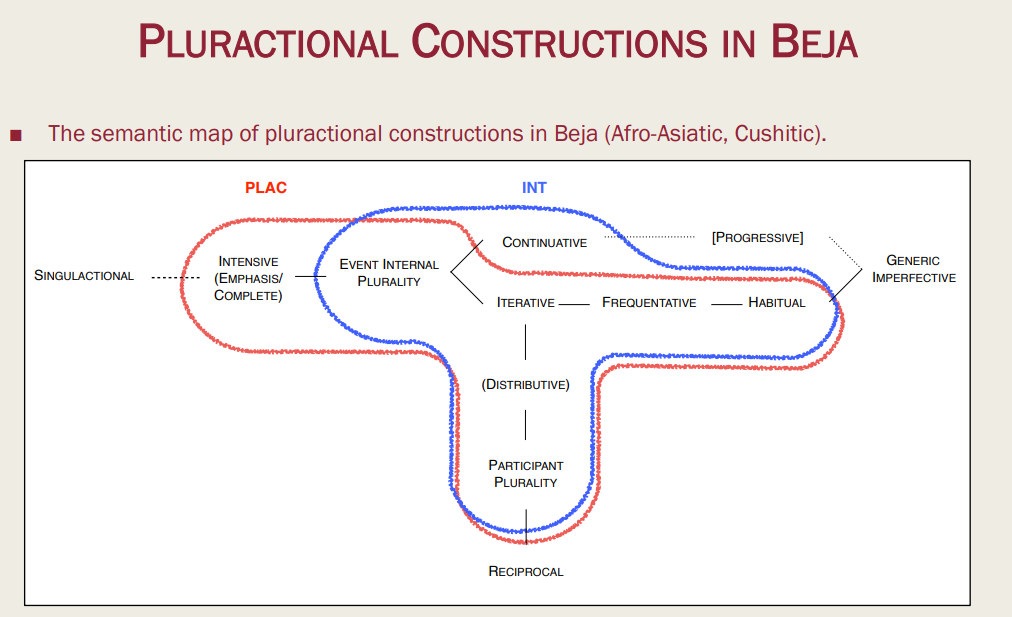Page 162 of 180
Re: Conlang Random Thread
Posted: Fri Sep 20, 2024 3:15 am
by bradrn
keenir wrote: ↑Fri Sep 20, 2024 3:08 am
Ahzoh wrote: ↑Fri Sep 20, 2024 1:07 am
Don't mean to be snarky, but I'm frustrated by talking about things that don't need to be said. I've been conlanging for 10+ years, I know very well the ambiguity and flexibility of terminology. And I think we all agree that pluractionality is about an action itself being plural, and that results in all sorts of different semantic (aspectual) manifestations.
bradrn wrote: ↑Fri Sep 20, 2024 1:03 amIf the basic meaning of a marker is completeness, I wouldn’t call it a pluractional.
Well no, it's not the basic meaning, the basic meaning is a plurality of action. Completeness is just one manifestation of that.
didn't Creyeditor just explain this to you and I? its the number of events, not about number of the arguments.
Those two often go together, though. That’s one of the things which make this such an interesting area.
(Of course, there are many languages where pluractionality and object number are marked independently, e.g. Georgian.)
Re: Conlang Random Thread
Posted: Fri Sep 20, 2024 3:23 am
by Ahzoh
keenir wrote: ↑Fri Sep 20, 2024 3:08 am
Ahzoh wrote: ↑Fri Sep 20, 2024 1:07 am
Don't mean to be snarky, but I'm frustrated by talking about things that don't need to be said. I've been conlanging for 10+ years, I know very well the ambiguity and flexibility of terminology. And I think we all agree that pluractionality is about an action itself being plural, and that results in all sorts of different semantic (aspectual) manifestations.
bradrn wrote: ↑Fri Sep 20, 2024 1:03 amIf the basic meaning of a marker is completeness, I wouldn’t call it a pluractional.
Well no, it's not the basic meaning, the basic meaning is a plurality of action. Completeness is just one manifestation of that.
didn't Creyeditor just explain this to you and I? its the number of events, not about number of the arguments.
I said plurality of action (i.e. events or states) not plurality of participants (though they often go together).
It was only you who had confused grammatical number (quantity of participants) with pluractionality (and which Creyeditor clarified for you), but I was not confused on that.
Re: Conlang Random Thread
Posted: Fri Sep 20, 2024 1:28 pm
by Ahzoh
There is a concept map of pluractionality, which is pretty complex

- semanticmapofpluractionality.png (43.41 KiB) Viewed 3138 times
Hittite for example:

- hittitepluractional.png (128.5 KiB) Viewed 3138 times
And Beja:

- bejapluractional.png (76.65 KiB) Viewed 3138 times
I only want one pluractional marker (PM), so I want to decide on an optimal semantic range that can be used for most verbs. For example, I can't think of a pluractional meaning to stative verbs like "be good" or "be old" other than "participant plurality". Maybe they can't be pluractional.
The more I try to understand it the less appealing the idea becomes, especially when I don't understand it enough to know when such a form should be used.
Re: Conlang Random Thread
Posted: Fri Sep 20, 2024 8:13 pm
by bradrn
Ahzoh wrote: ↑Fri Sep 20, 2024 1:28 pm
There is a concept map of pluractionality, which is pretty complex
Reference(s) please? I always like semantic maps.
The more I try to understand it the less appealing the idea becomes, especially when I don't understand it enough to know when such a form should be used.
I’m going to suggest another reference here:
Wood 2007 (open-access). Chapters 4 and 5 are in-depth studies of pluractionality in Yurok and Chechen, respectively.
Re: Conlang Random Thread
Posted: Fri Sep 20, 2024 9:15 pm
by Richard W
Ahzoh wrote: ↑Fri Sep 20, 2024 1:28 pm
I only want one pluractional marker (PM), so I want to decide on an optimal semantic range that can be used for most verbs. For example, I can't think of a pluractional meaning to stative verbs like "be good" or "be old" other than "participant plurality". Maybe they can't be pluractional.
How about multiple manifestations of the quality? So for "be old" we might have a pluractional meaning "to act senile". I may be being misled by the non-stative English "to be good", whose meaning can include "to behave oneself", as in "I was being good while the visitors were here".
Re: Conlang Random Thread
Posted: Fri Sep 20, 2024 9:24 pm
by Ahzoh
bradrn wrote: ↑Fri Sep 20, 2024 8:13 pm
Ahzoh wrote: ↑Fri Sep 20, 2024 1:28 pm
There is a concept map of pluractionality, which is pretty complex
Reference(s) please? I always like semantic maps.
A November 2016 presentation by Simone Mattiola that this
article on Hittite Pluractionality also references. And I can't seem to post the PDF I have. Since they also go over the semantic maps of PMs in Maa and Akawaio
Re: Conlang Random Thread
Posted: Fri Sep 20, 2024 9:31 pm
by Ahzoh
Richard W wrote: ↑Fri Sep 20, 2024 9:15 pm
Ahzoh wrote: ↑Fri Sep 20, 2024 1:28 pm
I only want one pluractional marker (PM), so I want to decide on an optimal semantic range that can be used for most verbs. For example, I can't think of a pluractional meaning to stative verbs like "be good" or "be old" other than "participant plurality". Maybe they can't be pluractional.
How about multiple manifestations of the quality? So for "be old" we might have a pluractional meaning "to act senile". I may be being misled by the non-stative English "to be good", whose meaning can include "to behave oneself", as in "I was being good while the visitors were here".
The statives I mentioned in particular are attributive. Like verbal equivalents to adjectives. Though at least in Semitic languages, attributive verbs end up becoming inchoative or inceptive (e.g. to be old > to become old; to be good > to become good) while their adjective counterparts remain attributive.
Re: Conlang Random Thread
Posted: Fri Sep 20, 2024 9:44 pm
by bradrn
Ahzoh wrote: ↑Fri Sep 20, 2024 9:24 pm
bradrn wrote: ↑Fri Sep 20, 2024 8:13 pm
Ahzoh wrote: ↑Fri Sep 20, 2024 1:28 pm
There is a concept map of pluractionality, which is pretty complex
Reference(s) please? I always like semantic maps.
A November 2016 presentation by Simone Mattiola that this
article on Hittite Pluractionality also references. And I can't seem to post the PDF I have. Since they also go over the semantic maps of PMs in Maa and Akawaio
Thanks!
Re: Conlang Random Thread
Posted: Sat Sep 21, 2024 5:00 am
by Richard W
Ahzoh wrote: ↑Fri Sep 20, 2024 9:31 pm
The statives I mentioned in particular are attributive. Like verbal equivalents to adjectives. Though at least in Semitic languages, attributive verbs end up becoming inchoative or inceptive (e.g. to be old > to become old; to be good > to become good) while their adjective counterparts remain attributive.
Semitic doesn't provide a case of a pluractional marker on a stative verb looking for a meaning. In the perfective, the doubling of the middle radical of a Semitic stative already has an interpretation, as a causative. The doubling of the middle radical is used as a mark of the imperfective in at least some branches.
Re: Conlang Random Thread
Posted: Sat Sep 21, 2024 11:12 am
by Ahzoh
Richard W wrote: ↑Sat Sep 21, 2024 5:00 am
Ahzoh wrote: ↑Fri Sep 20, 2024 9:31 pm
The statives I mentioned in particular are attributive. Like verbal equivalents to adjectives. Though at least in Semitic languages, attributive verbs end up becoming inchoative or inceptive (e.g. to be old > to become old; to be good > to become good) while their adjective counterparts remain attributive.
Semitic doesn't provide a case of a pluractional marker on a stative verb looking for a meaning. In the perfective, the doubling of the middle radical of a Semitic stative already has an interpretation, as a causative. The doubling of the middle radical is used as a mark of the imperfective in at least some branches.
That's only for some Semitic languages. Look at
Tigrinya where its D-stem is a dedicated frequentative or reciprocal marker while 'a- is the dedicated causative marker
I suppose a stative combined with a pluractional could take on a continuous sense, i.e "all humans keep growing older" (be old over and over) and "all humans strive to be good (be good over and over)"
Or even a habitual sense
Re: Conlang Random Thread
Posted: Sat Sep 21, 2024 4:21 pm
by Creyeditor
I was once told that in some languages (e.g. Wolof, IIRC), using progressive or habitual marking on states changes the meaning in unexpected ways. English does it in "She is being nice" (which kind if changes a state into an activity) and "he is a bird every tuesday" (which is supposed to induce a reversible change-of-state reaing).
Re: Conlang Random Thread
Posted: Sat Sep 21, 2024 4:35 pm
by Ahzoh
Creyeditor wrote: ↑Sat Sep 21, 2024 4:21 pm
I was once told that in some languages (e.g. Wolof, IIRC), using progressive or habitual marking on states changes the meaning in unexpected ways. English does it in "She is being nice" (which kind if changes a state into an activity) and "he is a bird every tuesday" (which is supposed to induce a reversible change-of-state reaing).
hmm, so "be_good" with a pluractional marker could have the meaning of "behave" or "be pious, be virtuous"
Re: Conlang Random Thread
Posted: Sun Sep 29, 2024 10:40 pm
by foxcatdog
Re: Conlang Random Thread
Posted: Fri Oct 04, 2024 6:40 pm
by ophois
ophois wrote: ↑Fri Oct 04, 2024 6:38 pm
Yet another new project. Notes dump:
Proto-lang:
/m n/
/p b t d k g/
/ɸ s x/
/l r j w/
VdV {VgV VxV} > diphthongs
b > β / V_V
w > β
V > Vː / _CV (also before resonant + voiced stop clusters at the same POA, i.e. /mb nd ŋg ld rd/)
C[-vcd] > C[+vcd] / V_V
Vs > Vː / _C
Cː > C
Palatalisation (blocked in trilling environments)
{mp mb} {nt nd} {ɲc ɲɟ} {ŋg ŋk} > ᵐb ⁿd ᶮɟ ᵑg
Syncope, followed by metathesis of non-velar + velar and click genesis (prenasalised stops give nasal clicks)
ᵑg > ŋ
ᵐb ⁿd > b͡ʙ d͡r > ʙ ɖ / trilling environments (back vowels?) (c.f. Nias)
{ɸ x} > h
t > k > ʔ (chain shift)
p c k > f ɕ kʰ
b d ɖ ɟ g > p t ʈ t͡ɕ k
ᵐb ⁿd ᶮɟ > b d d͡ʑ
As for vowels: height mutation a la Tangut and Great Vowel Shift a la English
/m n ɲ ŋ/
/p b t d ʈ t͡ɕ d͡ʑ k kʰ ʔ/
/f s ɕ h/
/β z l j/
/ʙ r/
/k͡ʘ k͡ǀ k͡ǂ/
/g͡ʘ g͡ǀ g͡ǂ/
/ŋ͡ʘ ŋ͡ǀ ŋ͡ǂ/
+ possibly /t͡ɬ d͡ɮ ɬ/ and lateral clicks (derived from /dl n(d)l tl/ etc.), uvulars and uvular clicks (inherited from protolang, t > k > ʔ shift is probably a t > k > q > ʔ)
Maybe also have the Grimm’s Law-esque shift in the plosives happen to the clicks as well, with tenuis clicks becoming implosives via an ejective stage (*k͡ǁ q͡ǁ became /l/)
Here’s what it would look like with all that:
/m n ɲ ŋ ɴ/
/p b ɓ t d ɗ t͡ɬ d͡ɮ ʈ t͡ɕ d͡ʑ ʄ k kʰ q ʔ/
/f s ɬ ɕ χ h/
/β z l j/
/ʙ r/
/k͡ʘ k͡ǀ k͡ǁ k͡ǂ q͡ʘ q͡ǀ q͡ǁ q͡ǂ/
/ŋ͡ʘ ŋ͡ǀ ŋ͡ǁ ŋ͡ǂ ɴ͡ʘ ɴ͡ǀ ɴ͡ǁ ɴ͡ǂ/
And then dump a heavily historical orthography akin to Nort’s Arve on top of that.
Crossposting this here to see what people think.
Edit: Heck, for shits and gigs, I could add linguolabials (from palatalised labials)
Re: Conlang Random Thread
Posted: Fri Oct 04, 2024 10:20 pm
by Travis B.
Just one thing that comes to mind ─ you detail two entirely different fates for each of /ᵐb ⁿd/; could you detail more when each of these fates occur, assuming this isn't an oversight?
Re: Conlang Random Thread
Posted: Fri Oct 04, 2024 10:22 pm
by Travis B.
Another thing is I would resist the urge to make a kitchen sink ─ a phonology often is characterized by not just what it includes but what it does not include.
Re: Conlang Random Thread
Posted: Fri Oct 04, 2024 10:52 pm
by ophois
Travis B. wrote: ↑Fri Oct 04, 2024 10:20 pm
Just one thing that comes to mind ─ you detail two entirely different fates for each of /ᵐb ⁿd/; could you detail more when each of these fates occur, assuming this isn't an oversight?
Note I specify "trilling environments". I haven't decided exactly what that'll be, but it'll probably have something to do with back vowels (bilabial trills often result from bilabial stops before *u, retroflexion before back vowels is common, and it'll provide a parsimonious explanation for why palatalisation doesn't occur here).
Travis B. wrote: ↑Fri Oct 04, 2024 10:22 pm
Another thing is I would resist the urge to make a kitchen sink ─ a phonology often is characterized by not just what it includes but what it does not include.
Yes, well aware of that. But this is more of an experiment in what I can make diachronics do in a somewhat naturalistic fashion. The eventual highly historic orthography plays into that. And also, there are plenty of interesting (and diachronically justified) gaps, such as /ʈ kʰ/ being the only retroflex and aspirated consonants, respectively.
Re: Conlang Random Thread
Posted: Tue Oct 08, 2024 8:42 pm
by Ahzoh
Today I had an epiphany.
Over the past 17 years of my life that I have been conlanging, I have come to conclude this:
It is important to learn the rules of things, so that you may know when to safely and responsibly break them.
And I think it can apply to many things. Certainly to language: Think of the countless greats of the English language who enriched it by bending or breaking the "rules" of English grammar. Like Shakespeare and Chaucer.
I especially think about this one English author who wrote a book entirely without punctuation. The book was almost entirely a run-on sentence. He broke the conventional rules of English writing, yet he did so creatively and in a way that enhanced the language, rather than making it confusing and unpleasant.
And I think about how I have a good enough grasp of linguistics and how languages in general operate that I can in turn reasonably and creatively do things that would, on a surface level, seem to defy conventional linguistic understanding.
Re: Conlang Random Thread
Posted: Wed Oct 09, 2024 2:38 am
by bradrn
Ahzoh wrote: ↑Tue Oct 08, 2024 8:42 pm
Today I had an epiphany.
Over the past 17 years of my life that I have been conlanging, I have come to conclude this:
It is important to learn the rules of things, so that you may know when to safely and responsibly break them.
Well done for coming to this realisation.
(I’ve seen this same point given as advice in all kinds of creative fields, by the way: ‘you need to know the rules before you can break them’.)
Re: Conlang Random Thread
Posted: Wed Oct 09, 2024 10:44 am
by Raphael
I've noticed that some ZBB members apparently took one and the same short text, translated it into something (their own conlangs?) and put that translation into their signatures. I mean the text where the last line consists of the same work repeated a couple of times. Which text is that?
